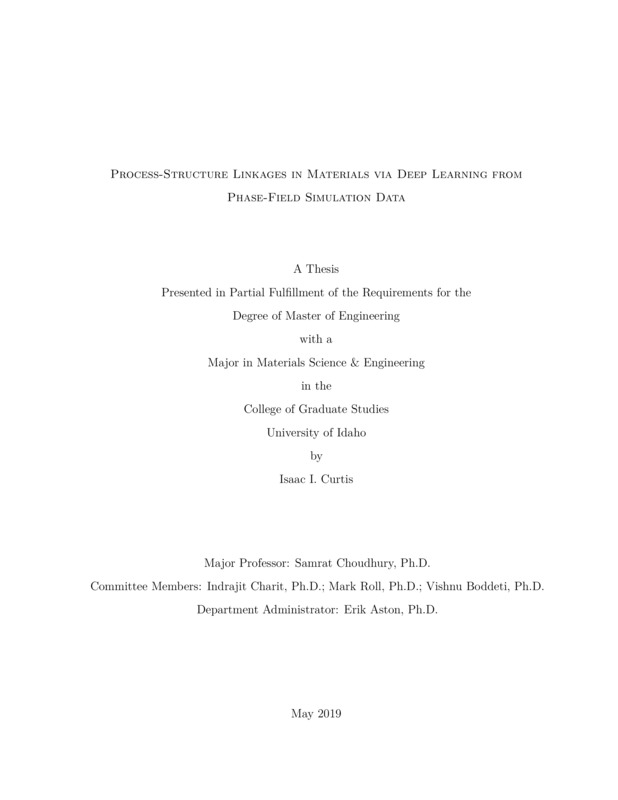Process-Structure Linkages in Materials via Deep Learning from Phase-Field Simulation Data
Curtis, Isaac. (2019-05). Process-Structure Linkages in Materials via Deep Learning from Phase-Field Simulation Data. Theses and Dissertations Collection, University of Idaho Library Digital Collections. https://www.lib.uidaho.edu/digital/etd/items/curtis_idaho_0089n_11501.html
- Title:
- Process-Structure Linkages in Materials via Deep Learning from Phase-Field Simulation Data
- Author:
- Curtis, Isaac
- Date:
- 2019-05
- Embargo Remove Date:
- 2021-07-10
- Keywords:
- Deep Learning Ferroelectrics Machine Learning Microstructure Variational Autoencoder
- Program:
- Chemical and Materials Science Engineering
- Subject Category:
- Materials Science; Engineering
- Abstract:
-
Material microstructure is key to understanding processing-structure-property relationships. However, limitations in computational descriptions of microstructure present a challenge in being able to predict property changes under noisy processing conditions. Correctly modeling microstructure and being able to produce reliable material property predictions would enable efficient strategies for material optimization. Such strategies are shown to drastically reduce the amount of experiments needed to reach an optimal material. This in turn would decrease the time to market required to develop new materials, a key goal of the material genome initiative.
In this work, a general mechanism for linking processing, structure, and properties is developed through the use of Deep Learning. Two separate models have been developed. The first model, the encoder-decoder model, is used to link processing conditions to microstructure, while the second model, the predictor model, is used to predict material properties given the current material microstructure. The trained encoder-decoder model is shown to predict the non-trivial evolution of ferroelectric domains in bi-crystalline lead titanate perovskites. In addition to small constant inputs such as the processing temperature, the encoder-decoder can account for spatial input conditions, such as the arrangement of grains in a polycrystalline material.
The predictor model uses the ferroelectric microstructure to predict the ferroelectric switching constant, the coercive field. It is demonstrated that the predictor model is able to model the coercive field property using only the microstructure with a similar level of accuracy as state-of-the-art machine learning methods that have been trained directly on input processing conditions. Even if the input conditions are unknown or noisy, the microstructure can often be observed accurately.
Further, the model has been demonstrated on more complicated environments with stochastic poly-crystalline systems. It is shown that the model is able to sufficiently capture and reproduce key characteristic features of the microstructure, despite never being explicitly programmed to do so. The overall volume fractions of domains is maintained, the formation of domain walls occur along directions expected analytically, and the polarization is reduced along grain boundaries in the presence of a secondary phase.
- Description:
- masters, M.S., Chemical and Materials Science Engineering -- University of Idaho - College of Graduate Studies, 2019-05
- Major Professor:
- Choudhury, Samrat
- Committee:
- Boddeti, Vishnu; Roll, Mark; Charit, Indrajit
- Defense Date:
- 2019-05
- Identifier:
- Curtis_idaho_0089N_11501
- Type:
- Text
- Format Original:
- Format:
- application/pdf
- Rights:
- In Copyright - Educational Use Permitted. For more information, please contact University of Idaho Library Special Collections and Archives Department at libspec@uidaho.edu.
- Standardized Rights:
- http://rightsstatements.org/vocab/InC-EDU/1.0/

